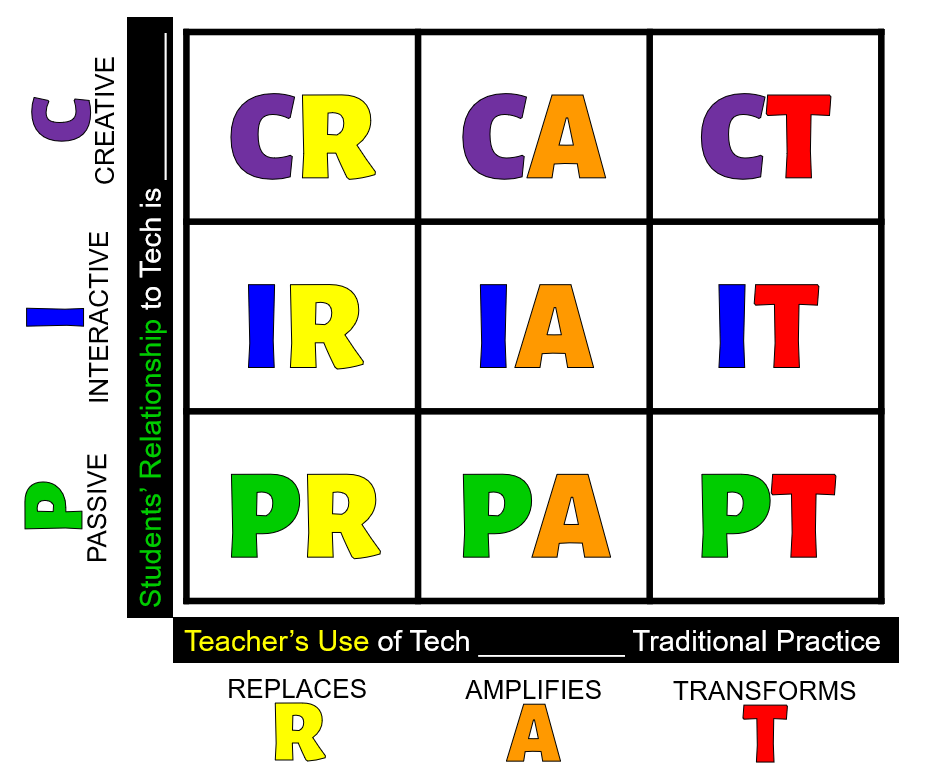Chat GPT can have many positives and numerous drawbacks in classroom settings. As a teacher I have found it helpful when adapting for student reading levels or to generate ideas for discussion prompts and word problems. As with any tool the challenge is in how we use it and how we teach students to use it. When implementing any new technology tool in our classrooms it comes back to the SAMR and PIC RAT models to deicide how and when to use a tool. (Kimmons, Graham, & West, 2020)
(Brubaker, 2013)
Thinking about generative AI with both of the models above it becomes clearer that we must develop ways to utilize the tool to enhance students learning like we would with any other technology tool. ChatGPT and others like it are here to stay we will not be able to completely ban the use of generative tools. I remember being a high school student in the early days of smart phones, any one remember the blackberry flip phones, and teachers trying to ban them and have us keep our phones in lockers. Banning the device didn’t stop us from bringing them to class and being distracted by them, it just made us sneaky. In the same way we need to teach our students appropriate use of generative AI from an early age and before they can build bad habits with it. Any technology can be a major hinderance to learning when used improperly but that has a flip side, used appropriately and intentionally new technologies can alter the way we teach and learn.
Of course, we aren’t going to teach our students to copy an essay or debate prompt into chat GPT and use the given text but it can be a tool to help with the ideating phase. Personally, I have used it to get the idea of a format for an unfamiliar written product and to see how to structure my writing in the new style. Chat GPT has also been helpful to reword sentences in a report card in a more politically correct manner, when I was stuck with how to rephase something I needed to communicate.
As teachers we are able to show our students the strength of generative AI in helping students formulate research questions, find questions for debates or get started on tasks. How ever when introducing it we also have the responsibility to teach them about the drawbacks and pitfalls beyond plagiarism. Generative AI does not fact check and does not check for bias in it’s outputs both of which could lead to students developing misconceptions. In December 2023, McDowell addressed bias in AI generated texts particularly around racial biases, he suggests several ways that students could change their prompts as well as strategies for discussing the bias with students (McDowell, December).
Strategies to have students assess AI outputs:
- Three Cs
- Critical
- Compare to class resources, published books and other websites as well as class discussions
- Ask AI additional questions to clarify the given response
- Criticality
- Evaluate what perspectives and voices are missing as well as the assumptions in the response
- Create a list of missing perspectives and voices
- Create a list of assumptions
- Have students look for errors and assumptions in the output
- Have students search for what is missing
- Have students fill in the gaps in the output
- Contribution
- As a class generate a list of arguments and questions that could be used with the AI tool to make the responses more accurate
- Ask students to address how they would respond to the same questions and prompts themselves
- Critical
- Perspective Analysis
- Based on Marzano’s work.
- Looks closely at an individuals point of view on the given topic
- Students look for relationships and connections to the topic and other information or view points
- Students identify own view point and that in the AI response as well as their reasoning
- Students work with AI to explore opposing view points
(McDowell, December)
References
Brubaker, J. (2013, November). SAMR: Model, Metaphor, Mistakes. Retrieved from Tech Tips for Education: https://techtipsedu.blogspot.com/2013/11/samr-model-metaphor-mistakes.html
Kimmons, R., Graham, C. R., & West, R. E. (2020). The PICRAT Model for Technology Integration in Teacher Preparation. CONTEMPORARY ISSUES IN TECHNOLOGY AND TEACHER EDUCATION.
McDowell, M. (December, 2023 20). Checking For Bias in AI Outputs. Retrieved from Edutopia: https://www.edutopia.org/article/checking-bias-ai-outputs
STAAKE, J. (2023, March 13). 20 Ways Teachers Can Use ChatGPT To Make Their Lives Easier. Retrieved from We Are Teachers: https://www.weareteachers.com/chatgpt-for-teachers/




